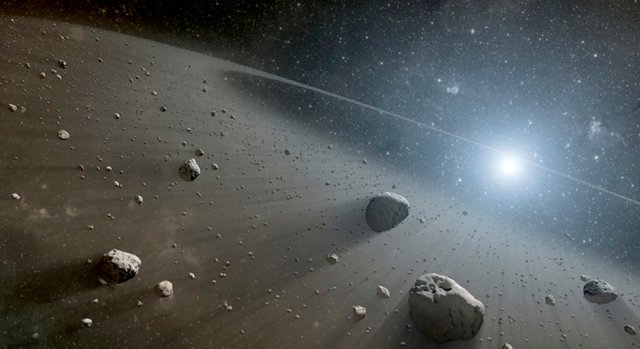Sun-like star Virginis 61, its planet system and debris disk
61 Virginis (or 61 Vir for short) is a G-type, 4.6 billion year old star. It is 4 -5% less by mass than our Sun and located 28 light years (8.52 par secs) away. There are at least three planets, that are 5, 18 and 22 times more massive than Earth, orbiting the star at elliptical orbits with large axis 0.05, 0.217 and 0.476 a.u. (one a.u.= distance from Earth to the Sun= 150 million kilometers).

Image: deviantArt - We cannot see Vir 61 planets, this is amazing artist's impression (see link): Vir 61 planets with satellites
Planets's locations are unusually elliptic

Only known planets are shown
One of the most intriguing features of this system is a debris disk, extending from 30 to at least 100 a.u. from the star. This is very unusual too - our Sun's debris disk, or Kuiper belt extends from 30 to only 50 a.u.

Image: NASA/Caltech
Astronomers have recently presented new results of observations, focused on investigating the system's debris disk, which could hold many clues to the nature of planetary formation beyond our solar system.
The team of astronomers led by Sebastian Marino of the University of Cambridge in the U.K., has performed observations of 61 Vir's debris disk using the Atacama Large Millimeter/submillimeter Array (ALMA) in Chile. These observations were complemented by data from the Submillimetre Common-User Bolometer Array 2 (SCUBA2) installed in the James Clerk Maxwell Telescope (JCMT) at Mauna Kea Observatory in Hawaii.
New study found that the debris disk is much larger than previously thought. New estimates are, that it extends from 30 to at least 150 a.u.
Another assumption says, that a yet unseen fourth planet may lurk somewhere in the system between 61 Vir d at 0.5 AU and the inner edge of the disc. This is very interesting, because the effective earth orbit radius (i.e., distance from the star, where planet would obtain the same energy as the Earth) is 0.87 a.u.
However, another argument is that if the disc was stirred at 150 AU by an additional planet, that unseen alien world should have a mass of at least 10 Earth masses and should orbit its host at a distance between 10 and 20 AU. This, of course, does not exclude, that Earth-like planet (or even not one) could exist in habitability zone.
The study shows the great variety of planet systems, even if their parent stars are similar in age, mass and spectral class
Further reading: ArXiv.org